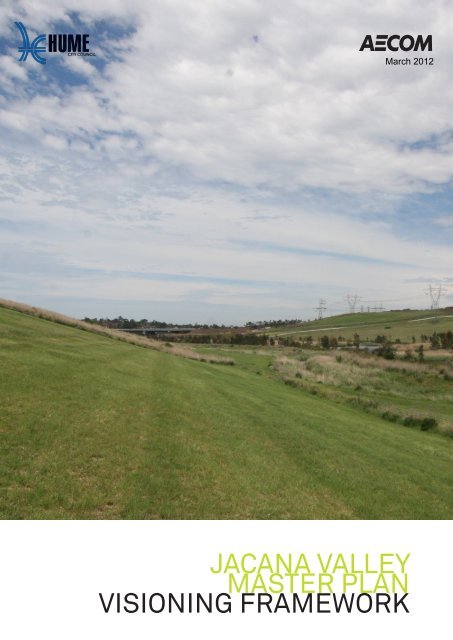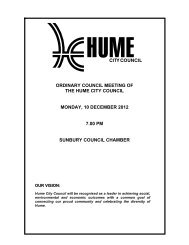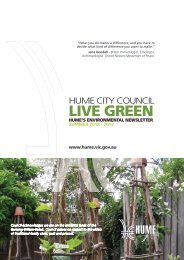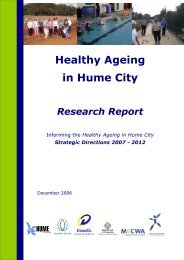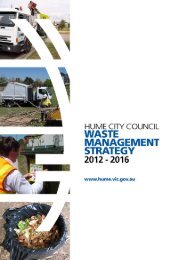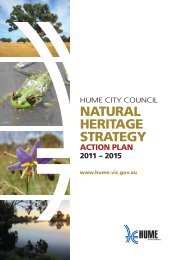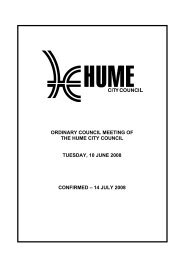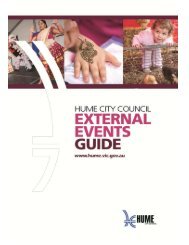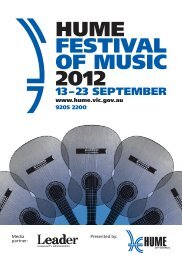jacana valley master plan visioning framework - Hume City Council
jacana valley master plan visioning framework - Hume City Council
jacana valley master plan visioning framework - Hume City Council
Create successful ePaper yourself
Turn your PDF publications into a flip-book with our unique Google optimized e-Paper software.
JACANA VALLEY<br />
MASTER PLAN<br />
VISIONING FRAMEWORK
Table of Contents<br />
Introduction ............................................................................................ p.3<br />
Objectives .............................................................................................. p.4<br />
Background ........................................................................................... p.5<br />
Consultation .......................................................................................... p.11<br />
Vision ..................................................................................................... p.18<br />
Themes .................................................................................................. p.19<br />
Actions ................................................................................................... p.20<br />
Appendix A ............................................................................................ p.24<br />
Appendix B ............................................................................................ p.26<br />
Appendix C ............................................................................................ p.27<br />
Appendix D ............................................................................................ p.30<br />
2
Introduction<br />
<strong>Hume</strong> <strong>City</strong> <strong>Council</strong> is preparing a <strong>master</strong> <strong>plan</strong> for the precinct<br />
consisting of Johnstone Street Reserve, Jacana Valley Park and<br />
the Moonee Ponds Creek wetland and surrounding parkland,<br />
known for the purposes of this study as the Jacana Valley Master<br />
Plan.<br />
‘The Master Plan will capture the community’s and <strong>Council</strong>’s<br />
aspirations of the precinct by articulating a vision which builds on<br />
the site’s uniqueness, and establish clear directions for the future<br />
use and functionality of the three sub-precincts.’<br />
This Visioning Framework aims to capture aspirations for the<br />
regeneration of Jacana Valley and will be the foundation<br />
document for a <strong>master</strong> <strong>plan</strong> for Jacana Valley to guide future<br />
<strong>plan</strong>s for this significant open space.<br />
Barry Road<br />
Westmeadows<br />
Broadmeadows<br />
Pascoe Vale Rd<br />
Broadmeadows/Craigieburn<br />
Johnstone Street<br />
Broadmeadows CAA<br />
Blair Street<br />
Gladstone Park<br />
Jacana Valley<br />
Jacana<br />
Camp Road<br />
<strong>City</strong> of Moreland Jurisdiction<br />
Widford Street<br />
Figure 1.1 Broader Site Context<br />
3
Objectives<br />
The <strong>visioning</strong> for Jacana Valley and consequent Master Plan<br />
responds to:<br />
• Clear vision established in partnership with a range of<br />
stakeholders.<br />
• Agreed <strong>visioning</strong> <strong>framework</strong> guiding prioritised decision making.<br />
• Engaged local community in the <strong>plan</strong>ning of the precinct/subprecints.<br />
• High quality urban design aesthetic objectives, including private<br />
realm.<br />
• Place making opportunities considering a range of functions<br />
and uses including community infrastructure, high-end land<br />
use opportunities (e.g. urban agriculture, social enterprise<br />
opportunities, commercial food services), active and passive<br />
recreation, family spaces, quiet contemplation and urban<br />
wilderness.<br />
• Sustainable and inclusive sports clubs that provide for local<br />
communities and respond to identified needs, including<br />
targeted participation programs from contemporary facilities<br />
that meet community expectation.<br />
• Sustainable environment outcomes including management<br />
strategies and general time frames to maintain the landfill<br />
cap on Johnstone Street Reserve, and any required ongoing/<br />
future remediation to improve the quality of water entering the<br />
Moonee Ponds Creek.<br />
• An intelligent design response which enhances the existing<br />
qualities of the site.<br />
• Role of open space in contributing to the proposed regeneration<br />
of Broadmeadows and supporting a regional catchment from<br />
across Melbourne’s north.<br />
• Explore opportunities to increase passive surveillance<br />
incorporating potential residential development.<br />
4
Background<br />
Landscape Character<br />
Jacana Valley is located approximately 13km north of Melbourne, boarded by suburbs of Jacana,<br />
Gladstone Park and Broadmeadows. Broadmeadows is set for extensive change over the next<br />
20 years. The Draft Broadmeadows Structure Plan (November 2011), aims to guide the area’s<br />
transformation into a ‘mini CBD’. The regeneration of Jacana Valley will play a major role in providing<br />
quality open space that responds to this ‘new city’ .<br />
The study precinct consists of three connected parcels of land: Johnstone Street Reserve, Jacana<br />
Valley Park and Freeland Grove Reserve in Jacana, and the Moonee Ponds Creek wetland and<br />
parkland west of the Creek to Gladstone Park.<br />
The regionally significant precinct connects to Broadmeadows Valley Park to the north, and the<br />
Moonee Ponds Creek Linear Parkland to the north-west and south in neighbouring Moreland <strong>City</strong><br />
<strong>Council</strong>. The precinct and adjoining open space serves a regional catchment and in part provides<br />
for the neighbourhood-level passive and district-level active recreation needs of residents in<br />
Broadmeadows, Gladstone Park and Jacana. The Metropolitan Trail Network extends through the<br />
study area.<br />
5
Metropolitan Trail Network<br />
Background<br />
Broadmeadows<br />
Valley Park<br />
Johnstone Street<br />
Broadmeadows<br />
Jacana<br />
Reserve<br />
Residential<br />
Residential<br />
Johnstone<br />
Street Reserve<br />
Extent of Study Area<br />
Gladstone<br />
Park<br />
Moonee Ponds Creek<br />
Jacana<br />
Valley Park<br />
Residential<br />
Jacana Reserve - sports<br />
ground and pavilions<br />
Johnstone Street Reserve -<br />
Playground, Skate Park and<br />
BBQ facilities<br />
Broadmeadows Sporting<br />
Club<br />
Moonee Ponds Creek<br />
Wetland<br />
Freeland<br />
Grove Reserve<br />
Jacana<br />
Residential<br />
M80 Western Ring Rd<br />
Jacana Valley<br />
Wetlands<br />
Figure 1.2 Existing Site Plan<br />
Not to Scale<br />
6
Background<br />
Characteristic<br />
Topography/<br />
Physiography<br />
Cultural/<br />
Heritage/<br />
Interpretation<br />
Geology<br />
Hydrology<br />
Accessibility<br />
Description<br />
• Jacana Valley Park is a wide, natural <strong>valley</strong> with the Moonee Ponds Creek forming it’s base.<br />
The informal parkland is a highly exposed space and has very steep topography. Johnstone<br />
Street Reserve has a steep and undulating geography with three ‘terraces’ for areas of<br />
passive and informal active recreation. There are two sports grounds utilised by the Jacana<br />
Cricket and Football clubs at Jacana Reserve. These sports grounds sit below the 1/100 year<br />
flood line.<br />
• Any indigenous significance will be dealt with in more detailed concepts that this Master<br />
Plan instigates.<br />
• Cultural and heritage significance will be promoted through interpretation via path networks,<br />
public art and potential future programs such as ‘Friends of Jacana Valley’ and voluntary<br />
natural resource management programs.<br />
• Johnstone Street Reserve is a former landfill over a narrow <strong>valley</strong> which provided storm<br />
water run off from Broadmeadows to the Moonee Ponds Creek. <strong>Council</strong> monitors the former<br />
landfill site through regular gas emission, surface and ground water quality and cap integrity<br />
testing and reporting. Previous use for landfill constrains future use options and existing<br />
landfill buffers must be retained.<br />
• The Moonee Ponds Creek line traverses the study area, passing through the Moonee Ponds<br />
Creek wetlands downstream in the south of the site. The creek and wetlands are both prone<br />
to flooding. The area adjacent to the creek that includes the Metropolitan Trail Network and<br />
the two sports grounds at Jacana Reserve sits under the 1/100 year flood line. The wetlands<br />
are arguably the most important asset along this creek line as it has suffered environmental<br />
impact from urban development upstream.<br />
• Major storm water infrastructure runs through the Johnstone Street Reserve. As this site is<br />
a former landfill, <strong>Hume</strong> monitors the surface water that is discharged from this pipe.<br />
• The site is accessible via Johnstone Street to the east and from Sunset Boulevard - the<br />
entrance to the Broadmeadows Sporting Club from which there are pedestrian through<br />
points into the reserve. Jack Ginifer Reserve in Gladstone Park and Pyke Drive only allow<br />
access to the top of the west escarpment. The two ovals and club rooms at Jacana<br />
Reserve are accessible via Loraine Crescent with a formal access path connecting into<br />
the Metropolitan Trail Network. A temporary shared path has been constructed as part of<br />
the M80 Ring Road widening works to the south west of the site which allows access from<br />
Jacana Valley to the south of the Ring Road.<br />
• The Metropolitan Trail Network extends through the study area from north to south and on<br />
the west side of the Moonee Ponds Creek, crossing it at two points via footbridges to the<br />
north and south of the site.<br />
• Meadowlink is a shared walking/cycling path through Broadmeadows proposed to move<br />
through Johnstone Street Reserve and connect to the Metropolitan Trail Network in Jacana<br />
Valley Park.<br />
7
Background<br />
Characteristic<br />
Flora and Fauna<br />
View lines<br />
Ownership<br />
Tenancy<br />
Zoning<br />
Description<br />
• The site provides habitat for the growling grass frog. This species is listed as Threatened<br />
under the Flora and Fauna Act 1988 and Vulnerable under the Federal Environment<br />
Protection and Biodiversity Conservation Act 1999.<br />
• There is little to no remnant vegetation on the site. Significant revegetation works have<br />
been undertaken along the Moonee Ponds Creek and associated Moonee Ponds Creek<br />
Wetlands.<br />
• An Environmental Significance Overlay under the <strong>Hume</strong> Planning Scheme covers the creek<br />
environs at the site (ESO2). The purpose of the overlay is to protect significant environmental<br />
values along the creek and ensure the function of the waterway to support natural waterway<br />
flow and provide and preserve habitat for wildlife.<br />
• The precinct has a significant profile from the Western Ring Road (M80) providing regional<br />
exposure into Broadmeadows and views beyond. The termination of Johnstone Street<br />
Reserve into the Valley in the east and the top of the escarpment to the west provide vantage<br />
points to striking, open views across the <strong>valley</strong>.<br />
• <strong>Hume</strong> <strong>City</strong> <strong>Council</strong> - Freeland Grove Reserve, Johnstone Street Reserve and Jacana Valley<br />
Park east of the <strong>valley</strong> that includes the Broadmeadows Sporting Club, and Jacana Reserve<br />
down to the 1/100 year flood line.<br />
• Melbourne Water - Moonee Ponds Creek and Wetlands and Jacana Reserve up to the 1/100<br />
year flood line.<br />
• VicRoads - The parcel of land west of the <strong>valley</strong> reserved for the E-14 extension down to the<br />
1/100 year flood line, along with small parcel of land located in the south east of the site<br />
abutting Freeland Grove Reserve.<br />
<strong>Hume</strong> <strong>City</strong> <strong>Council</strong> has a range of tenancy arrangements operating across the study area:<br />
• lease of area developed for car parking east of Johnstone Street Reserve to Northern Health<br />
• lease to Broadmeadows Sporting Club lease<br />
• Seasonal license agreements with Jacana Football Club, Jacana Cricket Club and other<br />
sports clubs as required.<br />
• Johnstone Street Reserve and Freeland Grove Reserve are zoned Public Park Recreation<br />
Zone (PPRZ)<br />
• The Melbourne Water land and VicRoads E-14 easement is zoned Public Use Zone 1 (PUZ1)<br />
• The small parcel of VicRoads land to the south east is zoned Residential Zone 1 (R1Z)<br />
8
Background<br />
Planning Context<br />
Identifying and understanding the <strong>plan</strong>ning context for the<br />
Johnstone Street Reserve, Jacana Valley Park and Moonee<br />
Ponds Creek is critical in establishing a Master Plan that can<br />
be implemented and to represent the strategic and statutory<br />
policies of <strong>Hume</strong> <strong>City</strong> <strong>Council</strong>.<br />
Summary of Planning Context<br />
The Master Plan, in terms of <strong>plan</strong>ning, will not be contrary to any<br />
of the existing <strong>Hume</strong> <strong>Council</strong> Policy, Legislative Requirements or<br />
<strong>Hume</strong> Planning Scheme.<br />
Points of consideration include:<br />
• The over arching State and Local Policies do not prohibit the<br />
preparation of the Jacana Valley Master Plan. These strategies<br />
support the <strong>master</strong> <strong>plan</strong>ning, activation and connection of this<br />
area to surrounding land uses.<br />
• The legislative <strong>framework</strong> protecting areas of conservation<br />
significance, in particular the threatened species of Growling<br />
Grass Frog should be noted.<br />
• Within the Public Park and Recreation Zone (PPRZ), retail<br />
premises (including café) are conditionally permitted. This may<br />
be a suitable use to activate the area.<br />
• There are pertinent overlays in the study area of note.<br />
Consideration should be given to these in the Jacana Valley<br />
Master Plan.<br />
• Under the Planning and Environment Act 1987 changes in the<br />
PPRZ land are to be based on substantiated need and Planning<br />
Minister approval.<br />
Refer to the appendices for a detailed summation on all<br />
background <strong>plan</strong>ning documents and policies along with<br />
a preliminary assessment of residential development<br />
opportunities.<br />
9
Background<br />
Johnstone Street<br />
Broadmeadows<br />
Extent of Study Area<br />
Gladstone<br />
Park<br />
Vic Roads<br />
Melbourne Water<br />
<strong>Hume</strong> <strong>City</strong> <strong>Council</strong><br />
Jacana<br />
M80 Western Ring Rd<br />
Figure 1.3 Ownership<br />
Not to Scale<br />
10
Consultation<br />
Ascertaining the views and opinions of the community,<br />
particularly those from traditionally underrepresented residents<br />
and community groups is essential in the success of the Jacana<br />
Valley Master Plan. Our aim is to ensure that the consultation<br />
outcomes and findings meet the needs of the current and future<br />
users of this site. As such, we proposed targeted consultation<br />
of local government and authorities, key stakeholders and the<br />
local community to gather information to inform this Visioning<br />
Framework and eventually the Master Plan.<br />
For the Jacana Valley Master Plan, <strong>Council</strong> employed the<br />
consultation technique of Appreciative Inquiry. This is a valuesbased<br />
approach to consultation. It focuses on engaging those<br />
with a vested interest in a place, along with raising awareness<br />
to other members of the community to develop an interest in<br />
that place. By firmly anchoring the consultation dialogue in the<br />
values of a place, the results will always be focussed toward<br />
community’s stories, histories, affinities and identification with<br />
that place. In turn, those connections will promote value-based<br />
aspirations for a site that can be more tangibly linked to spaces,<br />
programmes, infrastructure, amenities and a range of investment<br />
opportunities.<br />
The community engagement offered a range of options as<br />
follows:<br />
• Online Survey<br />
• Survey Mail out<br />
• Government Agencies and Key Stakeholder Workshop<br />
• Broader Community Group and End Users Workshop<br />
• Community BBQ<br />
• Tenant sports club meeting<br />
11
Consultation<br />
The findings and outcomes from the data drawn from the consultation process focuses on<br />
identifying the key values that the stakeholders and community members already held<br />
and projected for Jacana Valley. The following table outlines the key findings.<br />
Consultation Activity 01<br />
Stakeholder Workshop 1<br />
Government agencies<br />
and key stakeholders<br />
workshop#1<br />
Description + Participants<br />
The purpose of this workshop was to engage with the <strong>Council</strong> and key stakeholder<br />
agencies to provide an overview of the Master Plan Project.<br />
• To gather their input into the Master Plan in terms of what they value<br />
• What key principles they would like to see incorporated?<br />
• To launch the Appreciative Inquiry approach<br />
• To uncover key champions who are willing to help the Inquiry process<br />
Attendees included:<br />
• Vic Roads<br />
• Moreland <strong>City</strong> <strong>Council</strong><br />
• Melbourne Water<br />
• Moonee Ponds Creek Co-ordination Committee<br />
• Victoria Police<br />
Facilitated by :<br />
• <strong>Hume</strong> <strong>City</strong> <strong>Council</strong><br />
• AECOM<br />
Findings + Outcomes<br />
Key values were drawn out by asking attendees to project what Jacana Valley could<br />
be in the future, what they valued about the space currently and also discussing<br />
what they valued about other open spaces that they have enjoyed.<br />
Key values drawn from this discussion were:<br />
• Accessibility and connectivity - through stakeholders identifying the need for<br />
improved DDA access, footbridges, boardwalks, connections over the creek and<br />
a trail that supplies both sides of the creek, a space that provides good public<br />
amenity through toilets, shade, water fountains, cafes, strengthening bike and<br />
pedestrian connections. It was noted that if the E-14 is ever constructed this will<br />
impact greatly on access from the Gladstone Park interface, west of the site.<br />
• Activation - through the stakeholder group identifying the need to maintain and<br />
consolidate the sporting precinct, shared community facilities .<br />
• Productive environment - through the stakeholder group identifying the desire for<br />
community gardens.<br />
• Security - through the group identifying the need for passive surveillance through<br />
activation and the potential for the existing ‘back fences’ that currently interface<br />
the reserve to become ‘inward facing’.<br />
• Conservation - through the group identifying the need for the Moonee Ponds Creek<br />
wetland to maintain flood capacity, increasing revegetation.<br />
• Responsiveness - through identifying the critical importance of <strong>Council</strong><br />
implementing the <strong>plan</strong> and the need for ongoing maintenance for the project.<br />
• Respect for others - through the group identifying the need for interpretation and<br />
inspiring the community to develop a connection to this space.<br />
• Simplicity - through the group identifying the need for signage, way finding and a<br />
legible landscape.<br />
• Regional scale - the group recognising that the Jacana Valley needs to be<br />
recognised on a regional scale/regional asset.<br />
12
Consultation<br />
Consultation Activity 02<br />
Survey - Online<br />
Consultation Activity 03<br />
Survey - Hard copy mail out<br />
Description + Participants<br />
Survey based on Appreciative Inquiry approach and asked three main questions,<br />
what they currently use the park for (or why they currently don’t), what they value<br />
about the park currently and what aspirations they had for Jacana Valley in the<br />
future. Posted on <strong>Hume</strong> <strong>City</strong> <strong>Council</strong> Website. The majority of respondents were<br />
from Gladstone Park and Broadmeadows making up 26 of the 41 respondents.<br />
Findings + Outcomes<br />
• 93 % of respondents have visited the park in the past 12 months with just under<br />
half usually spending 1-3 hours there at a time<br />
• The main reasons for not using the park were identified as feelings of insecurity<br />
and the fact that there is nothing to do there.<br />
• The main activities already participated in were identified by respondents as<br />
being: enjoying the outdoor/natural environment, exercising, general recreation for<br />
health and well being and dog walking.<br />
• The main activities respondents would like to see in Jacana Valley were identified<br />
as: environmental restoration, passive activities such as walking through nature,<br />
interpretation and public art.<br />
• The key values that were identified by respondents as desirable for Jacana to<br />
possess were identified as: accessibility, cleanliness and orderliness, community,<br />
conservation, family, health and well being, peace and quiet, pleasure, protection,<br />
safety, security and tranquillity.<br />
Description + Participants<br />
Survey questions as per as online survey.<br />
Mailed out to residents within a 3 km radius - 5, 800 no. total surveys were posted<br />
• Out of the 5, 800 surveys 180 were returned. The majority of respondents were<br />
from the Broadmeadows and Gowanbrae area making up 72% of those that<br />
replied.<br />
Findings + Outcomes<br />
• 63% of residents who responded had visited the park in the last 12 months, with<br />
those who don’t use the park identifying reasons as being too busy, too far from<br />
where they live, facilities not matching needs/nothing to do there and difficulty in<br />
accessibility.<br />
• Currently respondents mainly use the park to engage in organised sporting<br />
activities or as part of their exercise routine. Other uses identified were dog<br />
walking and enjoying the environment.<br />
• The main programs and activities respondents identified as wanting to see in<br />
Jacana Valley were a social/cultural calendar of events (33%), community gardens<br />
(35%), more activities for family (28%), children (28%) and young adults (21%), BBQ<br />
and picnic activities (29%) as well as passive activities (39%) and active activities<br />
(26%).<br />
• The key values respondents want Jacana Valley to posses were identified as: civic<br />
pride (23%), cleanliness/orderliness (52%), conservation (35%), fun (36%), peace<br />
+ quiet (47%), tranquillity (37%), productive (28%), environment (52%), simplicity<br />
(10%), diversity (7%), neighbourliness (20%), safety (55%), security (41%), family<br />
(41%), education (22%), respect for others (46%), health and well being (50%),<br />
respect for law (41%), pleasure (32%), nature (52%), accessibility (34%).<br />
13
Consultation<br />
Introduction<br />
Consultation Activity 04<br />
Community BBQ<br />
Description + Participants<br />
Community members were invited to a free BBQ in Johnstone Street Reserve.<br />
Approximately fifty local community members attended with a demographic ranging<br />
from families, youth using the skate park and playground as was well more elderly<br />
members of the local community.<br />
The AECOM and <strong>Hume</strong> team members were able to engage with the local community<br />
raising awareness for the project and inspiring a vested interest in contributing<br />
ideas through formal responses and also uncovering key champions who are willing<br />
to help the Inquiry process.<br />
Facilitated by :<br />
• <strong>Hume</strong> <strong>City</strong> <strong>Council</strong><br />
• AECOM<br />
Findings + Outcomes<br />
• Formal responses are included in the hard copy mail out findings + outcomes.<br />
• Participants spoke positively of the recent development of new informal recreation<br />
facilities at Johnstone Street Reserve including the skate park, flying fox and<br />
nature-based play spaces, and suggested additional sports be catered for such as<br />
tennis, bocce and soccer.<br />
• Support for additional recreation facilities in the reserve including spaces for<br />
family/social gatherings and facilities for children and young people.<br />
• Sought greater access to the <strong>valley</strong> and creek corridor through trails and shared<br />
paths.<br />
• Residents valued the precinct’s natural setting, and sought greater opportunity to<br />
experience and care for the natural environment including access to the creek and<br />
wetland.<br />
• Residents valued the importance of large, mature trees, and the opportunity to<br />
capitalise on the <strong>valley</strong>’s unique topography/setting by creating viewing points and<br />
use of the steep escarpments for different activities.<br />
• Connected spaces supported by program of events and activities that draws the<br />
community together.<br />
14
Consultation<br />
Consultation Activity 05<br />
Stakeholder Workshop 2<br />
Broader community<br />
group and end users<br />
workshop<br />
Description + Participants<br />
The purpose of this workshop was to engage with the key user groups and<br />
community groups (friends of groups, environment groups, religious spiritual groups,<br />
sports clubs, mothers groups other potential end users to provide an overview of the<br />
Master Plan Project.<br />
• To gather their input into the Master<br />
• Plan in terms of what they value<br />
• What key principles they would like to see incorporated?<br />
• To launch the Appreciative Inquiry approach<br />
• To uncover key champions who are willing to help the Inquiry process.<br />
Attendees included:<br />
• Metropolitan Fire Board<br />
• Jacana Football Club<br />
• Jacana Cricket Club<br />
• Kororoit Institute Proponents and Supporters Association<br />
• <strong>Hume</strong> BUG<br />
• Broadmeadows Rotary<br />
• Friends of Upper Moonee Ponds Creek<br />
Facilitated by :<br />
• <strong>Hume</strong> <strong>City</strong> <strong>Council</strong><br />
• AECOM<br />
Findings + Outcomes<br />
• All the participants are engaged to see improvements for the site.<br />
• The football and cricket clubs are keen to see a clear direction pertaining to the<br />
improvement of their club and associated facilities.<br />
• MFB noted the importance of the path network as a means of emergency access.<br />
• There was a general consensus for the <strong>City</strong> to ensure ownership of the project and<br />
the site; to ‘convert’ the promise and deliver the outcomes from a strategic level<br />
through to operations, management and maintenance.<br />
• Ensure that any staged works match spatial connectivity of nodes, facilities and<br />
amenities.<br />
• Other specifics included a reconciliation between commuter and recreational<br />
cyclists through the site – that a meandering path might not always be the most<br />
appropriate proposition; ratification of car parking if amenities are to increase, and<br />
ensure outcomes are community focussed.<br />
15
Consultation<br />
Consultation Activity 06<br />
Tenant sports clubs meeting<br />
Description + Participants<br />
Site tenants Broadmeadows Sporting Club, Jacana Football Club and Jacana Cricket<br />
Club attended a meeting to discuss and explore <strong>plan</strong>s and aspirations for the study<br />
area and their respective clubs’ operations. Clubs occupy these facilities through<br />
tenancy agreements with <strong>Council</strong>.<br />
The meeting was facilitated by <strong>Hume</strong> <strong>City</strong> <strong>Council</strong>.<br />
Findings + Outcomes<br />
• Broadmeadows Sporting Club (BSC) is poorly located and difficult to access<br />
without a private vehicle.<br />
• The BSC seeks to modernise facilities in keeping with Broadmeadow’s<br />
regeneration and provide members and the community with an inviting and<br />
accessible facility that support a range of social, leisure and entertainment needs<br />
and becomes a community hub for Broadmeadows and Jacana. The club wishes to<br />
continue financially supporting a range of local community sporting clubs through<br />
proceeds from gaming revenue.<br />
• The BSC would consider relocating to Jacana Reserve to an integrated with<br />
modernised sports hub, with upgraded player and umpire facilities responding to<br />
the operational needs of the Jacana Football and Cricket clubs, and other seasonal<br />
sports tenants. The proposed integration of sporting facilities would need to<br />
consider an appropriate governance structure.<br />
• A proposal to relocate BSC to Jacana Reserve would need to take into account a<br />
range of <strong>plan</strong>ning and community needs including amenity impacts, traffic and<br />
parking requirements, gaming and liquor licences, 1 in 100 year flood inundation<br />
overlay.<br />
• Player facilities at Jacana Reserve are ageing, and are limited in supporting<br />
participation by women and girls and people with disabilities.<br />
• All clubs valued the importance of providing for young people and families, and<br />
delivering sporting programs and related activities in partnership with schools and<br />
other sporting bodies that brings the community together and provides choice.<br />
• Other identified sporting opportunities across the study area include exercise<br />
stations and fitness trails, spaces for personal trainers and outdoor fitness class<br />
and provision of other sports such as softball, tennis and soccer.<br />
• Improved vehicle and pedestrian access throughout the study area<br />
• Further investigate potential for residential development to assist in funding the<br />
Park’s redevelopment.<br />
• Consider alternative community uses of Broadmeadows Sporting Club should BSC<br />
relocated to Jacana Reserve.<br />
16
The vision and values that underpin the future direction of Jacana Valley have been identified<br />
through background analysis and consultation and aim to capture the essence of community and<br />
key stakeholder aspirations.<br />
It is proposed that the vision be realised through pursuing key themes that directly reflect the main<br />
values the we read and heard during the background and consultation process.<br />
Each theme outlines these values which have been coupled with an ‘action’. These actions, to be<br />
explored and developed in the <strong>master</strong> <strong>plan</strong>ning process, propose a way to spatially implement these<br />
values.<br />
17
Vision<br />
‘toward an action <strong>framework</strong>’<br />
Jacana Valley will be a key regional open space providing social,<br />
environmental, and urban connectivity for the community.<br />
It will provide a range of values and benefits; from being a place of natural beauty and quiet<br />
contemplation, to a social hub for sport and cultural activities. The community’s diversity and depth<br />
of heritage will drive the:<br />
• Implementation of high-quality, high-amenity landscape architecture that provides for a range of<br />
uses including: family spaces, active and passive recreation and urban agriculture,<br />
• Re-development and activation of regional sporting programs. Viable sporting clubs delivering a<br />
range of active recreation and associated social activities for members and the local community,<br />
• Transformation of the Valley into a community-based destination that is designed to create safety<br />
and security, reduce isolation and instigate a sense of place and identity with all user groups,<br />
• Environmental sustainability,<br />
• Improved accessibility within the Valley itself and to the broader context of Broadmeadows,<br />
parkland south of the M80 and beyond.<br />
• Development of a robust interpretation and public arts <strong>plan</strong>, and<br />
• The development of residential areas for the purposes of economic regeneration and improvement<br />
to the interface of the Valley.<br />
Johnstone Street<br />
Broadmeadows<br />
Gladstone Park<br />
Jacana<br />
M80 Western Ring Rd<br />
Figure 1.4 Vision Diagram<br />
18
Themes - Framing the Vision<br />
The Visioning Framework responds to the various background<br />
documents, complemented by the Appreciative Inquiry of the<br />
community and key stakeholders that sought feedback on the<br />
<strong>valley</strong>’s current and future values. From this, five themes have<br />
been identified from which key spatial components will be<br />
developed as a <strong>master</strong> <strong>plan</strong>. An Action Framework details short,<br />
medium and long-term targets to deliver the <strong>master</strong> <strong>plan</strong>.<br />
GOVERNANCE<br />
ECONOMIC<br />
REGENERATION<br />
ENVIRONMENT<br />
DESTINATION<br />
SOCIAL<br />
INFRASTRUCTURE<br />
CULTURE + ID<br />
19
Actions - Delivering the Vision<br />
GOVERNANCE<br />
Values<br />
civic pride,<br />
respect for law<br />
leadership + maintenance<br />
Thinking/Possibilities<br />
responsiveness<br />
authorities to ensure the<br />
delivery of the <strong>master</strong> <strong>plan</strong><br />
ENVIRONMENT<br />
Values<br />
cleanliness/orderliness<br />
maintenance<br />
Thinking/Possibilities<br />
conservation, nature<br />
riparian corridor, 1/100 year flood line, restoration ecology,<br />
habitat creation, urban tree <strong>plan</strong>ting<br />
fun<br />
activity based infrastructure + social programming to create<br />
an appropriate mix of activities<br />
peace + quiet,<br />
tranquillity<br />
ensure places for solitude + calm<br />
productive<br />
environment<br />
provide productive landscape<br />
20
Actions<br />
CULTURE + ID<br />
simplicity<br />
Values<br />
create a landscape that is<br />
legible + structured<br />
Thinking/Possibilities<br />
respect for others<br />
provide flexible land uses<br />
ensure space + amenities to provide celebrations<br />
connection to place through an interpretation of time<br />
neighbourliness<br />
community gardens<br />
SOCIAL<br />
INFRASTRUCTURE<br />
safety, security<br />
Values<br />
Thinking/Possibilities<br />
access, 12-14 hour use<br />
activity that increases perceptions of personal security<br />
accessibility<br />
provide multi- generational activity<br />
all ability access to key nodes<br />
provision of youth orientated activities<br />
accommodate commuter and recreational users<br />
family<br />
a place for both physical and social access, safety and equality<br />
21
Actions<br />
education<br />
create a landscape that allows for varied experiences and<br />
discovery<br />
activation, health and well<br />
being<br />
create a landscape that allows for varied experiences and<br />
discovery<br />
open space<br />
provide for both regional open space and neighbourhood open<br />
spaces serving local needs<br />
ECONOMIC<br />
REGENERATION<br />
regional scale<br />
Values<br />
Thinking/Possibilities<br />
create a place of iconicity that can be recognised on a regional<br />
scale<br />
pleasure create a ‘whole of life’ ,<br />
enduring landscape (materials)<br />
residential development<br />
consider certain fringes of the reserve to be sold and<br />
developed for residential purposes that front on to the reserve<br />
22
Appendices<br />
23
Appendix A<br />
Planning Context<br />
Policy Document<br />
<strong>Hume</strong> <strong>City</strong> Plan 2030<br />
<strong>Hume</strong> <strong>City</strong> <strong>Council</strong> 2009-2013 (2011<br />
Action Update)<br />
Municipal Public Health & Wellbeing<br />
Plan 2009-2013<br />
<strong>Hume</strong> Social Justice Charter 2007<br />
<strong>Hume</strong> Youth Strategy 2010-2013<br />
<strong>Hume</strong> <strong>City</strong> Development Principles:<br />
Recreation & Community Facilities<br />
2006<br />
Community Safety Strategy 2009-<br />
2013<br />
<strong>Hume</strong> <strong>City</strong> <strong>Council</strong> Pathways to<br />
Sustainability Framework, and<br />
Pathways to Sustainability Action<br />
Plan 2009-2013<br />
Broadmeadows Valley Park<br />
Management Plan 2007<br />
Key Policies and Objectives<br />
• The <strong>Hume</strong> <strong>City</strong> Plan 2030 has been developed by the community for<br />
the community to ensure that by the year 2030, <strong>Hume</strong> <strong>City</strong> will be<br />
recognised as the ideal location for healthy living, lifelong learning,<br />
employment, recreation, enjoyment and prosperity.<br />
• The Jacana Valley would assist in meeting the Themes and objectives<br />
of this <strong>plan</strong> including Prosperity, Community Wellbeing and<br />
Appearance of <strong>City</strong> and Environment.<br />
• The <strong>Hume</strong> <strong>City</strong> <strong>Council</strong> 2009-2013 (2011 Action Update) has similar<br />
policies and directions as the <strong>City</strong> Plan and the Jacana Valley would<br />
assist to meet these policies, in particular the Community Wellbeing<br />
for elements such as social inclusion, Health, Safety and Wellbeing<br />
and Arts, Leisure and Recreation.<br />
• This document seeks to improve health and wellbeing, all of which can<br />
be improved by improved access and utilisation of public space areas<br />
such as the Moonee Ponds Creek. Therefore the Jacana Valley is in<br />
accordance with the directions of this policy.<br />
• The Jacana Valley aims to provide increased access and quality<br />
of public open space, which is an indirect action in achieving the<br />
objectives of this policy document.<br />
• The Jacana Valley provides an opportunity to address the structural<br />
(i.e. facility provision) and non-structural (i.e. event and service<br />
provisions) aims and objectives of this policy.<br />
• This policy was prepared to ensure that new development provide<br />
for a broad range of accessible, sustainable, green open spaces and<br />
recreational opportunities, including active sports, playgrounds,<br />
passive recreation, formal and informal meeting and community<br />
facilities and spaces connected walking and cycling trails and<br />
pathways, waterways and preserved natural environments.<br />
• Responses from the community during this study identified that<br />
residents rated leisure centres and facilities, parks and open spaces<br />
as places where they felt the least safe.<br />
• This policy document also identifies the importance of safety in urban<br />
design which includes principles such as passive surveillance of<br />
space, linkages and open areas.<br />
• This document, with specific relation to the Jacana Valley and the<br />
study area are the maintenance, protection and improvement of public<br />
open spaces for recreation and biodiversity to ensure a sustainable<br />
urban environment.<br />
• The location of this park is north of the study area however actions,<br />
particularly in relation to water quality of the Moonee Ponds Creek will<br />
have impacts on the study area.<br />
• The key aspect will be to retain, connect and improve linkages<br />
between the two areas.<br />
24
Appendix A<br />
Policy Document<br />
Moonee Ponds Creek Strategic Plan<br />
2011<br />
Planning for Broadmeadows:<br />
Emerging Strategic Directions 2010<br />
Broadmeadows Central Activities<br />
District Structure Plan: Context and<br />
Discussion Report 2010<br />
Meadowlink Master Plan<br />
Broadmeadows Structure Plan (Draft)<br />
November 2011<br />
Landfill Bore & Water Quality Reports<br />
<strong>Hume</strong> <strong>City</strong> <strong>Council</strong> Open Space<br />
Strategy 2010 – 2015<br />
Key Policies and Objectives<br />
• This Strategic Plan recommends adopting an integrated approach to<br />
the Moonee Ponds Creek and the surrounding environs.<br />
• Specific strategies for the Jacana Valley include weed management,<br />
increase crossing opportunities, advocate to underground existing<br />
power lines, increase connectivity and linkages, incorporate policy<br />
into <strong>plan</strong>ning scheme and implement interpretation and revegetation<br />
strategies.<br />
• This document encompasses the community aspirations for the<br />
Broadmeadows Activity Centre.<br />
• Specifically, the main points are to create linkages (walking, cycling<br />
and biodiversity) between established areas and recreational areas<br />
along the Moonee Ponds Creek in the study area.<br />
• Future directions from this document include investigation of using<br />
small frontages of the study area to facilitate additional residential<br />
development fronting the public open space areas.<br />
• This Master Plan provides an over arching <strong>framework</strong> for the<br />
development of a walking, cycling and open space link between the<br />
Metropolitan Trail Network at Moonee Ponds Creek and Merlynston<br />
Creek via the Broadmeadows town centre and railway station which<br />
includes the study area.<br />
• The Master Plan encourages linkages between activity areas,<br />
recreational space and residential areas, on a macro scale around<br />
the broader area. The Jacana Valley will build on these principles on a<br />
micro scale for the study area.<br />
• The Draft Structure Plan includes the Johnston Street Reserve within<br />
the study area. Similar to other policy documents and strategies,<br />
the key to utilisation and better <strong>plan</strong>ning for the Johnston Street<br />
Reserve and the broader study areas is the improvement of linkages,<br />
biodiversity and usage of these recreational spaces.<br />
• The Jacana Valley Master Plan will build on these principles, on a<br />
micro scale and would not be contrary to any objectives or themes<br />
from this document.<br />
• Study area needs to respond to/reflect CAA’s regional catchment.<br />
• Methane risks to adjoining properties from the former landfill are<br />
generally low<br />
• Gas monitoring indicates that there is a low risk impact to adjoining<br />
residential dwellings however future development of this area is<br />
unknown and would require further environmental investigations<br />
• The <strong>Hume</strong> <strong>City</strong> Open Space Strategy 2010-15 has been prepared to<br />
provide a <strong>framework</strong> for the future <strong>plan</strong>ning and provision of open<br />
space across the municipality.<br />
• In relation to the Johnstone Street Reserve, the Strategy identifies the<br />
need for additional facilities.<br />
25
Introduction<br />
Appendix B<br />
Legislation<br />
Environmental Protection Act 1970<br />
The ongoing landfill management and rehabilitation of parts of Johnstone Street Reserve must be<br />
in accordance with the Environment Protection Act 1970. The landfill’s existing buffer to adjacent<br />
land uses must be maintained.<br />
Land Protection Act 1994<br />
The management and protection of stream flows along Moonee Ponds Creek must be in<br />
accordance with the Catchment and Land Protection Act 1994. Environmental Protection and<br />
Biodiversity Conservation Act 1999 and Flora and Fauna Act 1988. The Growling Grass Frog, a<br />
species classified ‘threatened’ under the Flora and Fauna Act 1988 and ‘vulnerable’ under the<br />
Federal Environment Protection and Biodiversity Conservation Act 1999 has been identified in<br />
the study area. The Jacana Valley Master Plan will not impact on their habitat or is any habitat<br />
proposed to be impacted. Consultation with Federal and State Authorities may be required.<br />
Planning and Environment Act 1987<br />
As specific in the Planning and Environment Act 1987, ensure any changes in land zoned Public<br />
Park and Recreation (PPRZ) be based on substantiated community need. The re-zoning of PPRZ<br />
land requires approval from the Minister of Planning.<br />
An Environmental Significance Overlay is in place along the Moonee Ponds Creek to protect<br />
significant environmental values ensuring the function of the waterway to support natural flow<br />
and preserving habitat for wildlife.<br />
The Victorian Native Vegetation Management: A Framework for Action 2002 requires net gain<br />
native vegetation offsets if/where native vegetation removal is recommended.<br />
26
Appendix C<br />
Planning Framework<br />
State Planning Policy Framework<br />
Settlement<br />
Planning is to anticipate and respond to the needs of existing and future communities through<br />
provision of zoned and serviced land for housing, employment, recreation and open space,<br />
commercial and community facilities and infrastructure.<br />
Of particular importance from this policy are the requirements for <strong>plan</strong>ning of Activity Centres (i.e.<br />
Broadmeadows) and provision for suitable Public Open Space.<br />
The Jacana Valley Master Plan will provide increased access to public open space and will be<br />
integrated through linkages (where possible) with the Broadmeadows Activity Area and is therefore<br />
in accordance with this policy.<br />
Environment & Landscape<br />
The Moonee Ponds Creek Environs is environmentally significant to the area and surrounding<br />
region in terms of native flora and fauna species.<br />
The Jacana Valley Master Plan will retain existing Environmental Planning Controls in the ESO for<br />
the creek and surrounding environs and therefore is not contrary to the policies and directions of<br />
this clause.<br />
The Biodiversity and Native Vegetation Management of this area will not be compromised as part of<br />
the Jacana Valley Master Plan.<br />
Environmental Risk<br />
The study area is subject to environmental risks including landfill / contamination and flooding, all<br />
of which will be considered in terms of both strategic and statutory <strong>plan</strong>ning obligations as part of<br />
the Jacana Valley Master Plan.<br />
The landfill area proposed uses will be in accordance with EPA policy and the uses surrounding<br />
and adjoining the Moonee Ponds Creek will be in accordance with <strong>Hume</strong> Planning Scheme and<br />
Melbourne Water requirements.<br />
Built Environment & Heritage<br />
This policy is pertinent in considering landscape and cultural heritage and urban design elements.<br />
The Jacana Valley Master Plan will consider these policy objectives and address linkages to<br />
landmarks and activities, design for safety, sustainability, cultural identity and neighbourhood<br />
character.<br />
27
Appendix C<br />
Housing<br />
There are potential opportunities to utilise part of the study area owned by <strong>Council</strong> for residential<br />
development. The <strong>City</strong> of <strong>Hume</strong> is a growth area and the rezoning of this land would be in accordance<br />
with State Policy for urban infill development within close proximity to the Broadmeadows Activity<br />
Area.<br />
Local Planning Policy Framework<br />
Community Wellbeing<br />
<strong>Hume</strong> <strong>City</strong> is distinguished by the diversity of its community and renowned for social justice,<br />
community inclusion and lifelong learning. <strong>Council</strong>’s role in creating and enhancing community<br />
wellbeing includes a wide range of community issues.<br />
In particular the Jacana Valley Master Plan will address the key elements of this clause including<br />
provision for housing, health and safety and community services and facilities.<br />
Natural & Built Environment<br />
This policy provides local content and support for the State Planning Policy Framework in relation to<br />
the natural and built environment. Similar to the above mentioned assessment, the Jacana Valley<br />
Master Plan will address issues of biodiversity, catchment and land management, landscapes, open<br />
space and heritage elements of the study area.<br />
Activity Centres<br />
The SPPF designates Broadmeadows as a Central Activity Area, providing similar services and<br />
functions to central Melbourne. As an activity centre it provides a range of retail, commercial,<br />
entertainment, employment, public services and community services and activities integrated with<br />
housing in a location which is highly accessible by road, public transport and bicycle.<br />
Zones & Overlays<br />
Public Use Zone (PUZ1) – Service & Utility<br />
The purpose of this zone is to recognise public land use for public utility and community services<br />
and facilities and provide for associated uses that are consistent with the intent of the public land<br />
reservation or purpose.<br />
This land is known to be owned by both VicRoads and Melbourne Water for service provisions<br />
(existing and future) the Jacana Valley Master Plan must be in accordance with these land uses and<br />
consultation with these authorities will be required.<br />
28
Introduction<br />
Appendix C<br />
Public Park and Recreation Zone (PPRZ)<br />
The purpose of this zone is to recognise areas for public recreation and open space, protect<br />
and conserve areas of significance where appropriate and provide for commercial uses where<br />
appropriate.<br />
This land is owned by <strong>Hume</strong> <strong>City</strong> <strong>Council</strong> and the Jacana Valley Master Plan is an opportunity to<br />
build on existing policy for the <strong>plan</strong>ning of the area.<br />
Retail Premises (i.e. café) uses are conditionally permitted within this zone.<br />
Residential 1 Zone (R1Z)<br />
There is a small strip of R1Z land within Jacana Reserve fronting Johnstone Street opposite<br />
Westfield Boulevard. Within the local area, residential dwellings would appear to the be the<br />
highest and best use for R1Z land in the study area.<br />
Environmental Significance Overlay (ESO2) – Merri and Moonee Ponds Creeks Environs<br />
The key objectives of this overlay are to maintain and improve the ecological function, waterway<br />
function, recreation use, landscape character and heritage of these areas.<br />
The Jacana Valley Master Plan would seek to build and enhance on these objectives for the study<br />
area including Moonee Ponds Creek.<br />
Melbourne Airports Environs Overlay (MAEO2)<br />
This applies to a small portion of the VicRoads land on the western edge of the study area and is<br />
not considered to be important in relation to the Jacana Valley Master Plan.<br />
Public Acquisition Overlay (PAO1)<br />
This applies to part of the VicRoads land required for the proposed E18 connection road linking<br />
north of the study area to the Western Ring Road along the western boundary of the study<br />
area and section on east near Freeland Grove Reserve above Broadmeadows Sporting Club.<br />
Development of the E14 would have a significant impact on the precinct’s functions and values.<br />
Special Building Overlay (SBO)<br />
This applies to sections of the study area that are subject to inundation and development<br />
should retain a free passage and temporary storage of floodwaters, minimise flood damage,<br />
be compatible with the flood hazard and local drainage conditions and should not cause<br />
significant rise in flood level or flow velocity. The study area will not be prone to negative levels of<br />
development in accordance with these objectives and should not impact on this overlay and the<br />
water quality of Moonee Ponds Creek.<br />
29
Appen<br />
dix D<br />
Preliminary Residential Development Opportunities<br />
33 Sunset Boulevard and Rear<br />
Sunset Boulevard, Jacana<br />
Size:<br />
23,000 m 2 ( 2.3 ha)<br />
Zone:<br />
Public Park and<br />
Recreation Zone<br />
(PPRZ)<br />
Overlays:<br />
Environmental<br />
Significance<br />
Overlay<br />
Estimated Yield: 40 lots (approx.)<br />
@ 500 m 2 per lot<br />
Access:<br />
Multiple entry<br />
points off Sunset<br />
Boulevard<br />
Design<br />
Terraced to<br />
Characteristic:<br />
minimise<br />
impact on<br />
existing<br />
property views<br />
into the <strong>valley</strong><br />
Facing <strong>valley</strong> to<br />
capitalise on<br />
views of <strong>valley</strong><br />
Buffer road<br />
separating<br />
residential<br />
allotments and<br />
areas of park<br />
creating<br />
connectivity<br />
and passive<br />
surveillance<br />
Infrastructure<br />
To be confirmed<br />
Requirements:<br />
Servicing:<br />
To be confirmed<br />
Contamination:<br />
To be confirmed<br />
Traffic:<br />
To be confirmed<br />
Geotechnical<br />
To be confirmed<br />
Analysis:<br />
Flora & Fauna: To be confirmed<br />
5 – 35 Freeland Grove, Jacanaa<br />
Size:<br />
14,000 m 2 (1.4<br />
ha)<br />
Zone:<br />
Public Park and<br />
Recreation Zone<br />
(PPRZ)<br />
Overlays:<br />
Not applicable<br />
Estimated Yield: 19 lots (approx.)<br />
@ 500 m 2 per lot<br />
Access:<br />
Via Freeland<br />
Grove (southern<br />
end of site)<br />
Infrastructure<br />
To be confirmed<br />
Requirements:<br />
Servicing:<br />
To be confirmed<br />
Contamination:<br />
To be confirmed<br />
Traffic:<br />
To be confirmed<br />
Geotechnical<br />
To be confirmed<br />
Analysis:<br />
Flora & Fauna: To be confirmed<br />
30


